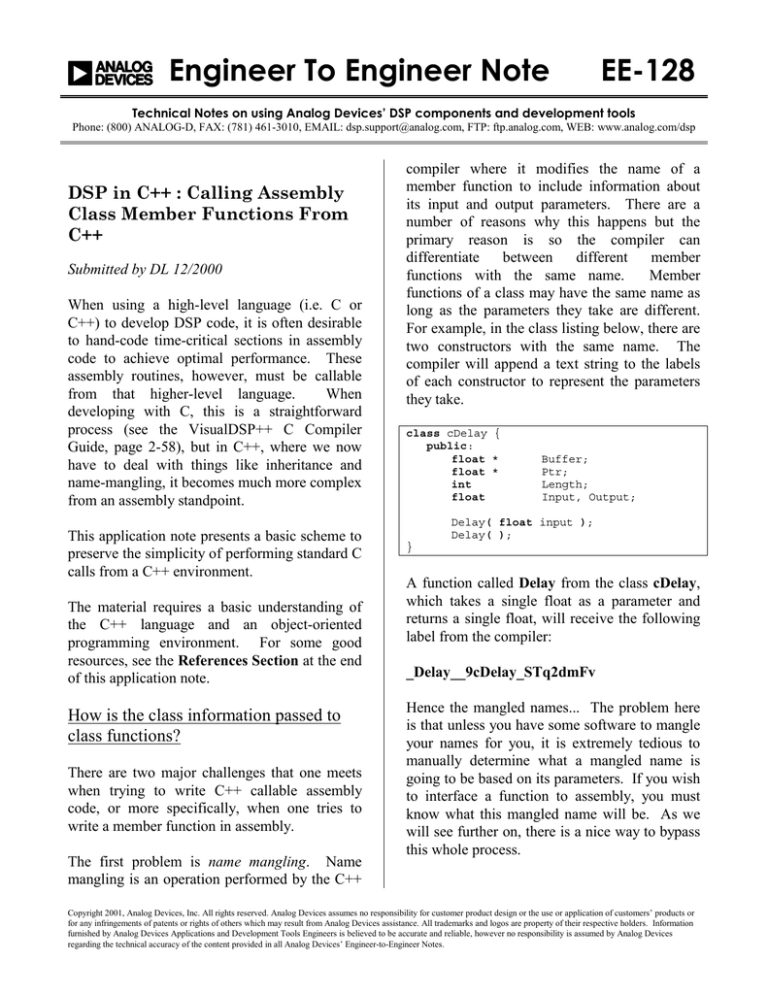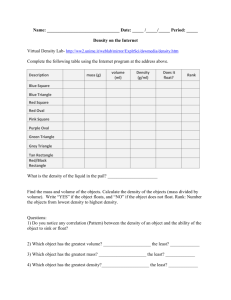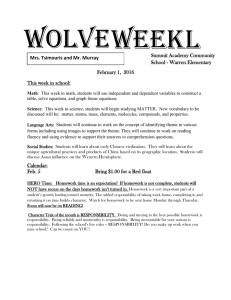Engineer To Engineer Note EE-128 a
advertisement

a Engineer To Engineer Note
EE-128
Technical Notes on using Analog Devices’ DSP components and development tools
Phone: (800) ANALOG-D, FAX: (781) 461-3010, EMAIL: dsp.support@analog.com, FTP: ftp.analog.com, WEB: www.analog.com/dsp
DSP in C++ : Calling Assembly
Class Member Functions From
C++
Submitted by DL 12/2000
When using a high-level language (i.e. C or
C++) to develop DSP code, it is often desirable
to hand-code time-critical sections in assembly
code to achieve optimal performance. These
assembly routines, however, must be callable
from that higher-level language.
When
developing with C, this is a straightforward
process (see the VisualDSP++ C Compiler
Guide, page 2-58), but in C++, where we now
have to deal with things like inheritance and
name-mangling, it becomes much more complex
from an assembly standpoint.
This application note presents a basic scheme to
preserve the simplicity of performing standard C
calls from a C++ environment.
The material requires a basic understanding of
the C++ language and an object-oriented
programming environment. For some good
resources, see the References Section at the end
of this application note.
How is the class information passed to
class functions?
There are two major challenges that one meets
when trying to write C++ callable assembly
code, or more specifically, when one tries to
write a member function in assembly.
The first problem is name mangling. Name
mangling is an operation performed by the C++
compiler where it modifies the name of a
member function to include information about
its input and output parameters. There are a
number of reasons why this happens but the
primary reason is so the compiler can
differentiate
between
different
member
functions with the same name.
Member
functions of a class may have the same name as
long as the parameters they take are different.
For example, in the class listing below, there are
two constructors with the same name. The
compiler will append a text string to the labels
of each constructor to represent the parameters
they take.
class cDelay {
public:
float *
float *
int
float
Buffer;
Ptr;
Length;
Input, Output;
Delay( float input );
Delay( );
}
A function called Delay from the class cDelay,
which takes a single float as a parameter and
returns a single float, will receive the following
label from the compiler:
_Delay__9cDelay_STq2dmFv
Hence the mangled names... The problem here
is that unless you have some software to mangle
your names for you, it is extremely tedious to
manually determine what a mangled name is
going to be based on its parameters. If you wish
to interface a function to assembly, you must
know what this mangled name will be. As we
will see further on, there is a nice way to bypass
this whole process.
Copyright 2001, Analog Devices, Inc. All rights reserved. Analog Devices assumes no responsibility for customer product design or the use or application of customers’ products or
for any infringements of patents or rights of others which may result from Analog Devices assistance. All trademarks and logos are property of their respective holders. Information
furnished by Analog Devices Applications and Development Tools Engineers is believed to be accurate and reliable, however no responsibility is assumed by Analog Devices
regarding the technical accuracy of the content provided in all Analog Devices’ Engineer-to-Engineer Notes.
Now that we understand that name mangling is
something we want to avoid, if possible, let’s
address the second issue : how do we access the
information in an instance of a class from a
member function of that class.
When a
function is called in C++, the first argument
passed is the this pointer, or rather, the
pointer to the top of the class structure. This
passage is transparent to the programmer
(unless, of course, the programmer is trying to
program an assembly language function, which
we’ll get to soon).
In order to review how function parameters are
passed, we will first start with a C example.
When a C function is called, the parameters are
passed as follows:
1st parameter
2nd parameter
3rd parameter
4th parameter
5th parameter
…
-
R4 register
R8 register
R12 register
1st location of stack
2nd location of stack
For example, say we have a C function called
add whose prototype might look something like
this :
float add( float x, float y);
When we call Add, the x parameter is placed in
the R4 register and the y parameter is placed in
the R8 register.
From a C++ member function, the parameter
passing is slightly different. Instead of the first
parameter being passed in the R4 register, the
this pointer is passed in the R4 register and any
other parameters are passed in the same fashion
as is true for C, starting in the R8 register :
this (ptr to instance) R4 register
1st parameter R8 register
2nd parameter 3rd parameter 4th parameter …
R12 register
1st location of stack
2nd location of stack
Let’s start with the following class as an
example. In this example, the Add function will
add a real and an imaginary component to its
own Real and Imag variables. It will then return
the real sum.
Cplx_float.h
Class Complex_Float {
private :
float Real, Imag;
public :
Complex_Float();
// constructors
Complex_Float( float real,
float imag );
float Add( float real,
float imag );
};
If we declared a new instance of a
Complex_Float and called the Add function, the
parameters would be passed as follows :
R4 -
pointer to the current instance of
Complex_Float
R8 - real parameter
R12 - imag parameter
For both C and C++, the return argument of
a function is always placed in the R0 register.
Now suppose we wanted to hand-code the
complex Add routine that we just defined in
assembly code.
Add_.asm
#include <asm_sprt.h>
.segment /pm seg_pmco;
// function name is arbitrary
_AsmAdd:
.global _AsmAdd;
// r4 contains a pointer to the
// instance
i4 = r4;
EE-128
Page 2
Technical Notes on using Analog Devices’ DSP components and development tools
Phone: (800) ANALOG-D, FAX: (781)461-3010, EMAIL: dsp.support@analog.com, FTP: ftp.analog.com, WEB: www.analog.com/dsp
//
//
r0
r1
fetch the Real and Imag values
from our instance
= dm(0,i4);
// Real
= dm(1,i4);
// Imag
// the real and imag parameters
// are in r8 and r12
// add real and imag components
// and then store back to memory
r8 = r8 + r0;
dm(0,i4) = r8, r12 = r12 + r1;
dm(1,i4) = r12;
// now we return the real part
r0 = r8;
leaf_exit;
.endseg;
At this point, we have an assembly language
function called _AsmAdd which we now want
to call directly from our member function, Add.
Most importantly, we don’t want to deal with
name mangling. In order to do this, we need to
make some slight changes to our class like so:
Cplx_float.h
class Complex_Float;
extern "asm" float _AddAsm(Complex_Float *,
float, float);
class Complex_Float {
private :
float Real, Imag;
public :
Complex_Float();
// constructors
Complex_Float( float real,
float imag );
inline float Add( float real,
float imag ) {
return _AddAsm(this,
real,
imag); }
};
What we are doing is using an inlined version of
Add to call our assembly function. The Add
function is gluing our assembly function and the
member function together. Because the Add
function has been declared as an inline function,
the second order of indirection here is
eliminated.
This brings us to the next question :
How is a class stored in memory?
A class is stored in the DSPs memory just like
a structure - each element is stored
contiguously and in the order in which it is
declared. For each instance of a class, we have
a block of data stored in the DSP’s memory.
For example, let’s start with a simple class to
represent a primitive packet of data:
Datapacket.h
class Packet
int
int *
int
};
{
bytes;
payload;
checksum;
Without diving too deeply into the C++
language, let’s declare these and initialize them
the
old-fashioned
way
(i.e.,
without
constructors) and see what we end up with in
memory.
Main.cpp
#include “datapacket.h”
// declare 2 instances of the data type,
// Packet
Packet packet0, packet1;
Main()
{
// initialize packet0
packet0.bytes = 10;
packet0.payload = new int [10];
packet0.checksum = 0x12;
// initialize packet1
packet1.bytes = 5;
packet1.payload = new int [5];
packet1.checksim = 0xAE;
}
Each instance of Packet (i.e., packet0 and
packet1) require 3 words of memory and will be
placed right next to each other in memory since
EE-128
Page 3
Technical Notes on using Analog Devices’ DSP components and development tools
Phone: (800) ANALOG-D, FAX: (781)461-3010, EMAIL: dsp.support@analog.com, FTP: ftp.analog.com, WEB: www.analog.com/dsp
we declared them consecutively. Let’s say, for
example, that the linker placed these two
instances beginning at location 0x31000. After
running through main(), the memory will look
like this:
If a class contains another class or a structure,
that data will be inserted into the class as well at
the location of the declaration.
Memory location
Contents
0x31000
0x31001
0x31002
0x31003
0x31004
0x31005
10
<- packet0
0x34000
0x12
5
<- packet1
0x3400A
0xAE
If a class receives inherited variables from a
parent class, the parent class data comes first
in memory. Let’s look at an example:
The location of class data is independent of
the declaration types, public, private or
protected. Class data will be stored in the order
in which it is declared.
What about inherited data!?
“cfir.h”
class Filter {
int type;
float gain;
};
// the cFIR class inherits from Filter
class cFIR : public cFilter {
If a class contains an array, the array data
will be stored within the class structure as
well. So, let’s revisit that last example in a
slightly different light:
Datapacket.h
class Packet
int
int
int
};
Coeffs;
Delay_Line;
Delay_Line_Ptr;
public:
int
float
Taps;
Input, Output;
// constructor
cFIR( float * coeffs,
float * delay_line,
int taps,
int type,
float gain );
{
bytes;
payload[5];
checksum;
In this case, we have changed the payload
variable to be a static array, which we will no
longer need to dynamically allocate space for.
This now means that the first memory location
of our instance will contain the bytes variable;
the next 5 locations will contain the values in
payload; and the last location will contain the
checksum variable. Instead of taking up 3
words of memory, each instance of this class
now takes up 7 words of memory. Of course,
we used memory from our heap when we
dynamically allocated space for the payload
variable, which required us to not only reserve
space for those elements but a pointer to those
elements as well.
private:
float *
float *
float *
// destructor
~cFIR();
};
In this example, we have the parent class, Filter,
which contains 2 variables – type and gain.
Below that, a child class has been declared,
cFIR, which inherits all of its parent’s (Filter)
variables as well. Again, the fact that some of
these have been declared as private and others as
public has no impact on where these will end up
in memory.
We can now create an instance of a cFIR in our
main code like so:
#include “cFIR.h”
EE-128
Page 4
Technical Notes on using Analog Devices’ DSP components and development tools
Phone: (800) ANALOG-D, FAX: (781)461-3010, EMAIL: dsp.support@analog.com, FTP: ftp.analog.com, WEB: www.analog.com/dsp
cFIR * my_filter;
float coeffs[33] = {
#include “my_coeffs.dat”
};
float delay[33];
main()
{
my_filter = new cFIR(coeffs,
delay,
33,
1,
1.0 );
}
In the example above, we used a constructor to
initialize the data rather than doing it manually
like in the previous example. So, let’s look at
how the data in my_filter is being stored. When
we perform the dynamic allocation to create an
instance of cFIR, the instance will end up in
heap memory where all dynamic memory
allocation needs are served. Let’s look at this
data in a slightly different fashion.
Memory Offset
0x0
0x1
0x2
0x3
0x4
0x5
0x6
things relatively simple. Concepts like static
member
variables,
virtual
functions,
polymorphism, and some of the other more
advanced C++ techniques will be covered in the
next application note of this series.
References
Schildt, Herbert: C++: The Complete Reference
1988, Osborne McGraw Hill
ISBN 0-07-882476-1
Visual DSP C Compiler Guide & Reference
2000, Analog Devices Inc.
Value
Type (inherited)
Gain (inherited)
Coeffs
Delay_Line
Delay_Line_Ptr
Input
Output
The point here is that inherited data comes first.
In addition, class function pointers (like
constructors and destructors) are not actually
stored in the class – this information is mostly
hardwired
by the compiler during
compilation.
Conclusion
While the C++ environment tends to be more
complex than its C counterpart, there are some
nice tricks we can take advantage of to keep
EE-128
Page 5
Technical Notes on using Analog Devices’ DSP components and development tools
Phone: (800) ANALOG-D, FAX: (781)461-3010, EMAIL: dsp.support@analog.com, FTP: ftp.analog.com, WEB: www.analog.com/dsp






